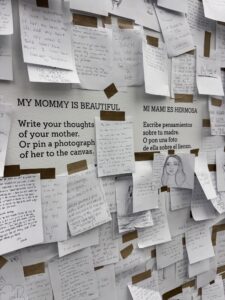Art and communication share a vital trait—they are most impactful when the energy flows both ways, making the experience interactive and reciprocal. In communication, we use phrases like “back and forth,” “give and take,” and “serve and return.” Similarly, artists seek to meet this need by creating spaces and works that invite active interpretation, participation, and feedback, turning the audience into co-creators of the artistic process.
Yoko Ono’s “Music of the Mind” exhibit at Chicago’s Museum of Contemporary Art reminded me of this. Ono has spent seven decades forging an art form rooted in a unique combination of language, art, and participation—a style that still resonates in 2025 and will beyond. As I walked through the exhibit, I noticed that nearly every work demanded audience participation. For example, in “My Mommy is Beautiful,” visitors were invited to write a memory about their mother and post it on a canvas stretching the length of the museum wall. Reading these hundreds of notes brought smiles, tears, and moments of deep reflection.

Clients often ask me, “How can I make my presentation more engaging?” “How can I grab my audience’s attention?” “How can I make what I’m saying relevant?” Ono’s “Music of the Mind” reminded me that, in both art and communication, what matters most is the exchange—the sharing of ideas, feelings, and perspectives. Without this exchange, you’re traveling down a one-way street, which, let’s face it, quickly becomes tiresome.
Although Ono herself wasn’t in the room, she invited us to engage. We played chess with all white pieces. We patched together broken china to create something new. We put our arm through a hole in a canvas and waited for someone on the other side to reach out and touch us. This experience made me reflect: When you’re speaking, training, or facilitating, how can you create this kind of meaningful connection?
Consider these strategies:
- Don’t just tell—give your audience something to DO.
- Invite your audience to co-create—ask how they think things should go.
- Leverage circular engagement: Present an idea, demonstrate it, have the audience try it themselves, and then debrief the experience together.
The goal is for everyone to walk away feeling like they’ve shared an experience—one they won’t soon forget.
Thank you, Yoko!







